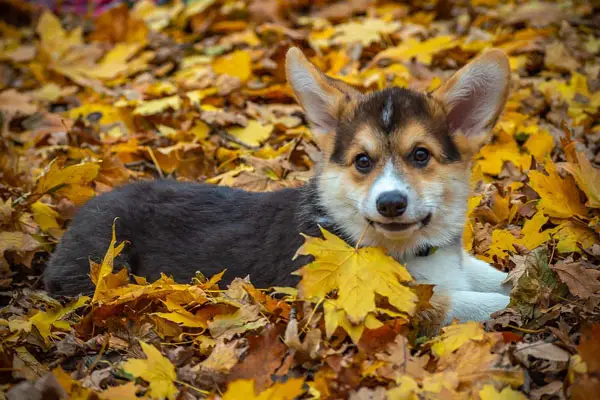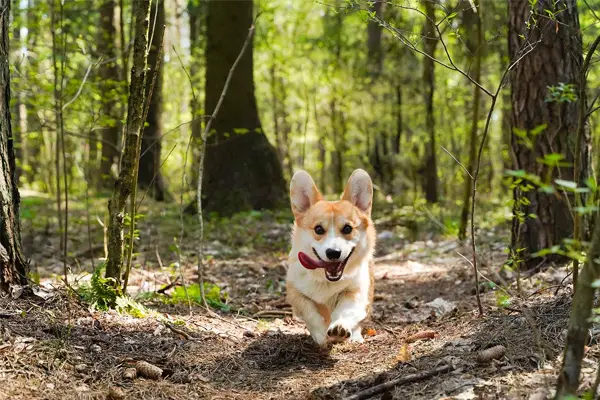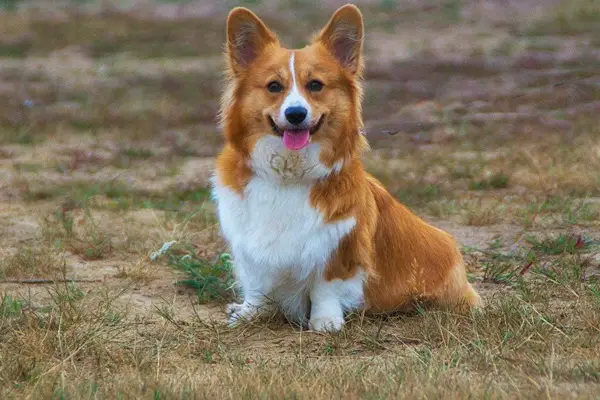Pembroke Welsh Corgis are the types of Welsh Corgis that come with a compact body and closely docked tails. They are also known to be short, have prick ears, and a foxy face. They were initially bred to herd cattle, horses, and sheep, and the Pembroke Welsh Corgi is the smallest of all the dog breeds in the herding group.
They are fast, have impressive agility, and brilliant dogs. They are straightforward to train and make excellent family dogs and companions even to children. Their playful nature makes them even more lovable that even the Queen of England couldn’t resist.

Pembroke Welsh Corgi Statistics
| Dog Breed Group | Herding |
| Breed Size | Small |
| Height | 10-12 inches |
| Weight | up to 30 pounds (male); up to 28 pounds (female) |
| Lifespan | 12-13 years |
Pembroke Welsh Corgi Ratings
| Energy level | |
| Exercise needs | |
| Requires attention | |
| Playfulness | |
| Trainability | |
| Shedding | |
| Grooming | |
| Friendly with family | |
| Friendly with kids | |
| Friendly with strangers | |
| Friendly with other dogs | |
| Prey Drive |
Related Article: Best Dog Food for Corgis
History
The history of Pembroke Welsh Corgis is rather enchanting. According to ancient folklore, Pembroke Welsh Corgis were a gift from fairies living in the fields. It believed that fairies used these pups to pull carriages and as rides into battle. The marks on the back of the Corgis are proof of this. And as great gifts by the fairies, these Corgis became treasured family companions that help a family take care of the cattle.
But, if you’re not interested in the fairytale, here’s the other version of their origin story.
Pembroke Welsh Corgis, as the name implies, originated from Pembrokeshire, Wales. It is one of the oldest breeds that is said to be traced back as far as 1107 AD. In that year, Henry I of Great Britain invited the best weavers to live and work in the southwestern part of Wales.
The craftsmen, having accepted the invitation, brought everything they needed to live a healthy life in a different country. They brought with them their dogs, described as sturdy, short-legged herders. These dogs are what is believed to be where the modern Pembroke Welsh Corgis descended.
There were no documents as to what went through to create the Pembroke Welsh Corgi, but it was only in the 1920s when the UK Kennel Club recognized Welsh Corgis as a pure breed. By 1934, the American Kennel Club identified two types of Welsh Corgis with one type being Pembroke.
It was only in 1936 when Pembroke Welsh Corgis were introduced in the US, and has been popular until today. But they are even more popular in the royal courts of Europe, especially in the court of Queen Elizabeth II.
Temperament
Pembroke Welsh Corgis are very playful and active. Herding, agility training, and chasing balls are a few activities that he would enjoy doing to keep up with his desire to work. They are intelligent dogs and would find the need to have something to do.
They are also very alert. They would react to even the slightest sound or anything out of the ordinary. This is then accompanied by a surprisingly loud bark coming from that small body. Because of this alertness, they can be excellent watchdogs.
Pembroke Welsh Corgis can be loving and affectionate to their humans. They also are excellent with family pets he grew up with. But as a previous herding dog, they can become very territorial and will chase strays away from your home. With strangers or guests, they can be polite and reserved; however, expect that they’ll keep an eye and will stay on high alert to these new people.
They are easy to train and can adapt quickly to any home situation. However, as much as they love pleasing their owners, they can be quite stubborn too, and love getting things his way. You can use food to convince them for training as they love eating.
You need to train Pembrokes at a younger age to get rid of the excessive barking, slight aggressiveness, and stubbornness. Training should be focused on socialization and obedience to decrease these unlikeable traits. As an owner, you should be firm, consistent, and confident. Also, you would need a lot of patience and persistence.

Care Requirements For Pembroke Welsh Corgis
- Nutrition: Pembroke Welsh Corgis love eating, so as the owner, it’s essential to watch out for their weight. Generally, Pembrokes would need two meals in a day. The amount you put will also depend on the dog’s size, activity level, and age. It’s also best to buy food with high-quality ingredients and make sure it contains well-balanced nutrients. Meat or protein should always be the primary ingredient of the food. You can then add vegetables to the diet as support. Just make sure that a balanced meal should contain 50-75% of animal protein, 15-18% fat, and 25% carbs.
- Grooming: Pembroke Welsh Corgis have a tick and weatherproof double coat that sheds daily. Brushing every day would help minimize the shedding before it hits any area of the house. Watch out for the shedding season in late spring or early summer. This would be a great time to bathe your Pembroke to help loosen dead hair. Just make sure to dry off the dog before brushing thoroughly, and you can also use a rake to help strip out the undercoat. Again, the same with any other dogs, check the ears and nails regularly too. Make sure the ears are clean and nails are trimmed.
- Exercise: Pembroke Welsh Corgis have an athletic nature because of their herding background. They love having things to do, which is why daily exercise is something that they need. It is even better if you do activities where he would have a goal. Try to mix up exercises such as in-home games, walks, puzzle toys, training, and fetch to keep him busy. Do this every day, and make sure not to skip. You wouldn’t want your Pembroke bored, or else they’ll find other things to do that will keep them busy, which might include destroying your house.
- Health: Just like other dogs, Pembroke Welsh Corgis can be prone to diseases as well. Although a typically healthy breed, it is still better to be aware of the common diseases that they might get. One particular problem that is of great concern is the Degenerative Myelopathy (DM). This is a progressive paralysis that, unfortunately, cannot be cured. Fortunately, tests can now be performed to detect this disease early. The long back can also cause Intervertebral Disc Disease, which is why it’s best to stay away from activities that might cause so much strain to the dog’s back. Health problems such as hip dysplasia, eye problems, and hypothyroidism are other diseases you need to watch out. They can also be prone to cryptorchidism, epilepsy, and reproductive issues.
- Lifespan: The life expectancy of Pembroke Welsh Corgis is 12-13 years.

Famous Pembroke Welsh Corgis
Holly: Corgi of Queen Elizabeth II; starred in 2012 London Olympics opening video
Ralph: Instagram famous Corgi with 238,000 followers
Molly: Stephen King’s Corgi; also called “The Thing of Evil” by the author
Ein: The Corgi from the beloved anime “Cowboy Bebop”
Corgi: Another Social Media famous corgi who loves dressing up; has 800,000 Facebook fans and 700,000 Instagram followers
Rufus: Amazon.com’s original mascot
Sutter Brown: The first dog of California; owned by Jerry Brown, the governor of California
Fun Facts About Pembroke Welsh Corgis
- Pembroke Welsh Corgis’ ancestry dates back to the 10th century.
- Although small, they belong to the top herding dogs.
- They are Queen Elizabeth II’s favorite dog breed.
- They are Huskies’ distant cousins.
Pembroke Welsh Corgis only evolved to be tailless. - Their coat has double layers that shed in the fall and summer.
- They are the 11th smartest dog breed.
Check Out Other Herding Dog Breeds:
Australian Cattle Dog, Australian Shepherd, Bearded Collies, Beaucerons, Belgian Malinois, Belgian Sheepdog, Belgian Tervuren, Bergamasco Sheepdog, Berger Picards, Border Collie, Bouviers des Flandres, Briards, Canaan Dog, Cardigan Welsh Corgis, Collie, Entlebucher Mountain Dogs, Finnish Lapphund, German Shepard, Miniature American Shepherd, Norwegian Buhunds, Old English Sheepdog, Polish Lowland Sheepdogs, Puli, Pumi, Pyrenean Shepherd, Shetland Sheepdog, Spanish Water Dog, Swedish Vallhunds
